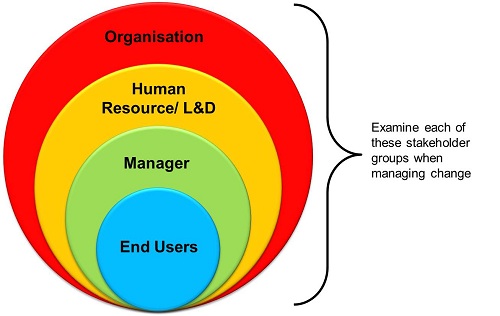 Question from client: What do we need to think about to manage the change associated with introducing technology into our learning strategy?
Question from client: What do we need to think about to manage the change associated with introducing technology into our learning strategy?
This is such a big topic that I thought I would respond over a series of blog posts. Today I’ll make comment on three broad questions. In later posts I’ll address each of the stakeholder groups captured in the diagram – Organisation, HR/L&D, Manager and End user. I will also try to distinguish different business models such as Corporate, Not-for-profit and external Training Provider.
“If we build it, why will they come?”
For end users to adopt technology, they must perceive that the return to do so is greater than their effort. i.e. RETURN > EFFORT.
There are two broad requirements to ensure your learning technology solution (e-learning, social media, video platform etc) is successful:
1. Effort – build the Imperative. Until the technology becomes part of habit, conscious effort is required of end users to remember the technology is available and to access the technology. End users must think the solution you have given them is imperative to their role and/or to their practice or they will not go out of their way to access it.
How to build Imperative? Link your solution to business objectives, workplace practice and team and individual development plans. Managers have an important role to play in building imperative.
2. Return – build the Value. Once end user accesses the technology, they must feel as though it was purposeful and of value to their professional development, practice or other personal objective. This means content must be relevant and fresh, and new information, courses, features or community members made obvious.
“Is it easy and intuitive to use?”
I will address this in more detail in subsequent posts, but I want to make mention that usability is a discipline in itself. I have seen many clients purchase the cheapest option, only to find poor usability inhibits adoption – it is just too much effort. This is particularly so if the technology is not accessed by end users often. The effort to remember and figure out how to do an action seems too great.
Administration (‘back end”) usability is also important, especially as the technology is often a new skill for learning practitioners. With today’s transient employees you may find yourself up-skilling a new administrator more often that you anticipated. So, make sure it’s easy.
“How do I prepare others for change?”
There are three broad initiatives for managing change:
1. Communication: Work with corporate comms (if you have one) to choose the best vehicles for communicating your new learning technology initiative (e.g. newsletter, poster, road-show etc)). Communicate the personal benefits simply, using real-life stories from advocates.
2. Education: Teach people how to use the new technology, using examples that are meaningful to them. Be sure to educate both the concept and the process. Use analogies to help people build their mental model of what the new technology is and what it does.
3. Model the new behaviour: The role of manager cannot be underestimated to demonstrate the benefits and the new behaviours associated with using the new technology. Use a bottom-up and top-down approach to encouraging user adoption. Promote end user advocates, and use these people to inform any usability ‘tweaks’ your technology may require.
In Part 2, I will write about change management from an organisational perspective.
To watch this e-learning change management series on our E-Learning Academy YouTube channel, go to our playlist: Managing Change in Organisational Learning.

Thanks for another clear and insightful article Alison, I agree that the product must be easy to use but it should also be engaging. As more companies and goverment departments move to online induction and compliance training all too often because they know people HAVE to do this training it is heavily text based , not much effort is expended on the design or thought provoking responses to questions to test knowledge. And then they wonder why they can’t get the same staff to engage in e-learning. It is not a good advertisement for the value of e-learning – little wonder then that these same staff resist online training solutions – especially if the level of design is little better.
Sadly online learning is still seen as a ” cheap” option – and it can save money in staff travel for training and so on but that money needs to be invested in creating well designed effective online training.
Hello Melaine. Thank you so much for your (always) insightful comment. Absolutely, there is a real issue in organisations using e-learning as a cheap option to disseminate content with little thought to learner engagement and, dare I say, having a positive and fun experience online. Too many times I see trainers who may have mastered the authoring tool (such as Articulate or Captivate), only to ignore the thought required to design good learning.
Even when our subject matter may be considered ‘dry’, the question we need to ask ourselves is, as you raise, “What can we do with learning and visual design techniques to make this subject engaging and memorable?” If we have difficulty with this question (such as having trouble coming up with ideas), then we should work with colleagues and experts to learn new techniques for turning content into learning design.
Thank you again, Alison
Great article. The leader of our change organization published a book on this very topic. Great resource! http://www.astd.org/Publications/Books/Change-Book.aspx
Thanks for sharing information on this ASTD resource, Freddy. Alison.